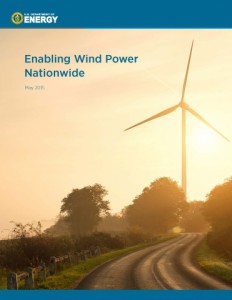U.S. Department of Energy (DOE) Secretary Ernest Moniz gave an engaging presentation during the WINDPOWER 2015 Conference and Exhibition taking place in Orlando, Florida. He noted that new wind resource maps are showing the ability for advanced wind turbines to reach stronger winds higher above the ground, unlocking a previously untapped wind resource area that the DOE believes could eventually bring wind energy development to every state in America.
Moniz delivered highlights from the new report “Enabling Wind Power Nationwide ,” which explains how new wind turbine designs are putting one of America’s largest domestic energy resources to use – the strong, consistent winds that can be found high above the ground in nearly all parts of the country.
,” which explains how new wind turbine designs are putting one of America’s largest domestic energy resources to use – the strong, consistent winds that can be found high above the ground in nearly all parts of the country.
“Wind generation has more than tripled in the United States in just six years, exceeding 4.5 percent of total generation, and we are focused on expanding its clean power potential to every state in the country,” said Energy Secretary Ernest Moniz. “By producing the next generation of larger and more efficient wind turbines, we can create thousands of new jobs and reduce greenhouse gas emissions, as we fully unlock wind power as a critical national resource.”
The Enabling Wind Power Nationwide report builds upon the DOE’s Wind Vision: A New Era for Wind Power report released this past March, which shows wind energy can become one of America’s top electricity sources, and save consumers money while doing so.
American Wind Energy Association (AWEA) CEO Tom Kiernan was quick to applaud the Secretary’s remarks, pointing out just a few of the ways Americans stand to benefit. “This report is great news for consumers, job-seekers, rural communities and many others in these states that have yet to fully benefit from American wind power,” said Kiernan. “Wind turbine technology has advanced in just a few decades from the Model T era to more like that of a Tesla Model S. Advanced towers, blades and improved electronics to operate and maintain the turbines are all part of this revolution.”
“The technological advances described by Secretary Moniz have redrawn the wind resource map, validating the opportunity for all states to host wind development. Our domestic wind resource is massive – enough to meet our electricity needs 10 times over – but largely untapped,” Kiernan added.
According to AWEA, more than 1,000 American wind turbines are already accessing higher wind resources with towers reaching 100 meters or more above the ground, rather than the 80 meter standard that had been the state-of-the-art for multiple years. Heights up to 120 meters or more are already common in Europe, allowing the stronger, steadier winds at that elevation to be tapped. At 110-meter hub heights, DOE expects the land area with physical potential for wind deployment in the U.S. to increase 54 percent (see maps below, found in Enabling Wind Power Nationwide), and at 140-meter hub heights, the potential wind deployment would increase 67 percent.
Advancement in turbine technology, including raising hub heights to 140 meters and lowering specific power, would open up an additional one-fifth of the land area of the United States for wind turbine locations, lighting up many parts of the country, especially the Southeast U.S.

